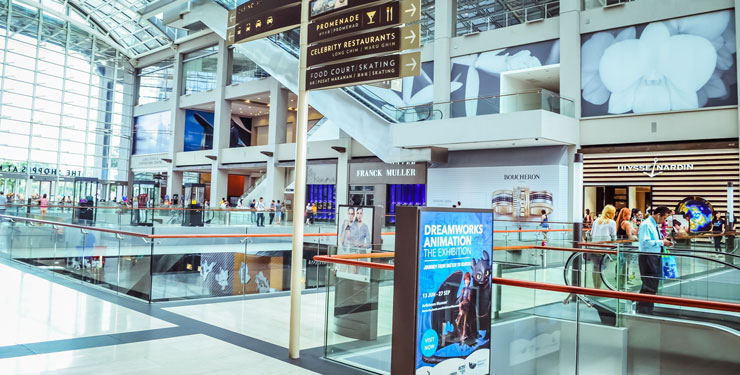
Shifting Consumer Shopping Behaviors and Its Ramifications for Retailers

Introduction
The United States retail landscape is experiencing a major paradigm shift when it comes to who controls and influences shopping decisions. This change has accelerated during the 2020 pandemic. Previously, retailers significantly influenced where and how consumers shopped by controlling selection, quality, location, price, and service. With the introduction of online and mobile shopping, buyers’ choices and habits broadened, creating more pressure for traditional retailers to maintain their market share. In this new environment, shoppers migrated to emerging omnichannel platforms with retailers that provided these options.
To reach a deeper understanding of the changing retail environment, BHDP surveyed 1,000 individuals who shopped at 25 specialty brand retailers to determine how they plan to shop in the future and the extent of this accelerated shift. The results showed that while at the start of the pandemic shoppers mostly had specific preferences on how and where they shopped, a significant number indicated they now no longer have a preference. This increase in “no preference” shopping represents the new baseline for the expectation of choice, thus removing the control from retailers and putting the shopper in charge. That means retailers need to pay attention and adapt to a new approach that puts buyers and their expectations, changed behaviors and decision-making emotional drivers at the center of the shopping experience. To address and solve for this transformation, retailers will need to work more strategically to seamlessly marry online with in-store messaging and experiences to provide multiple or “omni-choice” solutions for all shoppers.
Trends in the Retail Marketplace
The Retailers' Challenge
A crisis like the COVID-19 pandemic accelerates both upward and downward shopping trends. Before COVID-19, shoppers were gaining more control in the shopping battleground. When the 2020 pandemic hit, this trend exploded, and shoppers were exposed to and became more comfortable making omni-choice solutions to access and shop the products and services they are seeking. Many retailers are now playing catch up to stay in the game. Retailers with weak or no additional channels or options suffered the most during the pandemic lockdowns and gradual re-openings.
Ecommerce sales in the U.S. increased 14.9% between 2018 and 2019.1 While retail sales increased 3.8% to $3.763 trillion in 2019, more than half of these gains (56.9%) are from ecommerce. Additionally, U.S. e-commerce sales increased 30.1% in the first half of 2020, compared to the same period in 2019. The percentage of ecommerce sales has grown yearly from 5.1% in 2007 to 16% in 2019. If this trend continues, ecommerce is projected to reach $1 trillion in sales by 2025, representing over 20% of all U.S. retail sales, with Amazon’s Marketplace accounting for half of all online sales.
This increase in consumer behavior toward online shopping is pressuring brick and mortar retailers and design consultants to reevaluate how retail stores are planned and designed. Over the past 20-30 years, design thinking principles were leveraged to conceive, prototype and evaluate new store designs. The new emerging Purposeful Design approach assists retailers in uncovering the unmet needs of the shopper to shape the retail shopping experience. It takes a holistic look at all aspects of design including the peopl e, the organization, and other key influences through a collaborative exchange of information. Purposeful Design generates solutions that are innovative, not just incremental, and help retailers learn (and fail) faster.
Now, the sheer amount of shopper behavior al data provides ecommerce sites with an advantage that assists them in outpacing traditional retail, creating an ever-increasing negative impact on brick and mort ar retailers’ bottom line. Traditional retailers need to improve acquiring, understanding, and leveraging new forms of shopper behavioral data to win back shoppers with more meaningful and relevant in-store experiences.
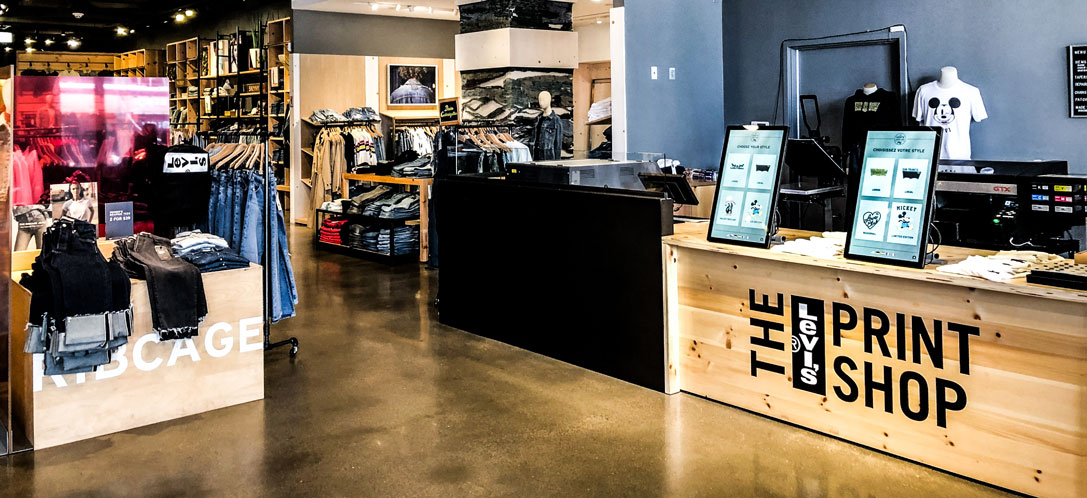
Levi's store in San Francisco, CA
Online retailers quickly curate the selection for each individual shopper based on their search history. These queries help identify the shoppers’ needs in real time, allowing online retailers to provide instant recommendations through “what others have also bought” messages and targeted ads. These online retailers are wooing shoppers whenever they power up their computers and smart phones and are training shoppers to expect immediate gratification. Some retailers already developed methods to deliver merchandise the same day. In fact, in some cities, Amazon guarantees 2-hour deliveries on key products.
As pressure mounts for brick and mortar retailers to adapt and become more competitive, those who do not will continue to experience declining sales and store closings. In 2018, more than 5,800 U.S. stores closed, while in 2019, there were 9,302 store closures, representing a 59% increase from 2018. Through August of 2020, the onset of the COVID-19 pandemic, 7,707 store closures were announced, yet there were only 3,344 store openings during the same time period. Retailers who understand their competitive edge still manage to compete, including discount brands (which compete well on price), such as Five Below, Burlington and Ollie’s Bargain Outlet. Additionally, online retailers continue to open brick and mortar channels as a way of creating deeper connections with their shoppers, which also drives growth in online sales in those areas.
At the same time, it is important to note that online shopping does not always generate as much revenue as in-store sales. One survey found that when shopping in-store, 71% of respondents spent more than $50, as compared to only 54% of respondents who spent more than $50 when shopping online. Another report highlighted that it is harder to upsell when orders are shipped directly to shoppers’ houses, but this opportunity only exists when shoppers elect to pick up online orders in the store. Plus, ‘free’ online returns are costly and decrease the online profit margins.
Beyond focusing solely on price, the retailers that are recognizing and investing in the shopper experience are starting to see some success. They are using a new approach to planning and designing stores, one where all the disciplines involved in conceiving, merchandising, building, and managing the stores leverage a collaborative, shopper focused, and data-driven process. With the continued rise of the internet and the stronger commitment of a Purposeful Design process by retailers and design consultants, retailers are leveraging customer data and shopper behaviors to make more informed and empathetic decisions, creating meaningful, relevant, and individual shopping experiences.
Clicks to Bricks Trends
A recent survey was initiated by BHDP of 1,000 adult U.S. shoppers who had experience purchasing both online and in “Clicks to Bricks” (C2B) stores.8 C2B brands are those that began as online only before opening brick and mortar stores. Several trends uncovered in this survey can help traditional retailers create omni-choices for shoppers. First, brand consistency is critical. Successful retailers establish a seamless transition from online to in-store shopping by designing the physic al space to reflect the aesthetic and voice of the online shopping experience and bringing their brand equities to life in a physical form. Second, shoppers want the opportunity to touch and feel the products and leave the store with product in hand or ordered with free shipping if the product is not available in-store. Most importantly, shoppers need to trust the brands they support. Traditional retailers can emulate the C2B model and be better prepared for future crises by learning more about how their loyal customers prefer to shop in a physical space and providing a cohesive online and in-store experience that satisfies their demands and desires.
The Shopper Experience
With the shopper in charge, it is no longer about the retailer selling product, but instead it is about improving the shopping experience in the physical space by providing more options. To move forward, valuable insights on specialty retail shopper behaviors and beliefs are needed to assist retailers in creating holistic omnichannel strategies to bring shoppers back to brick and mortar stores.
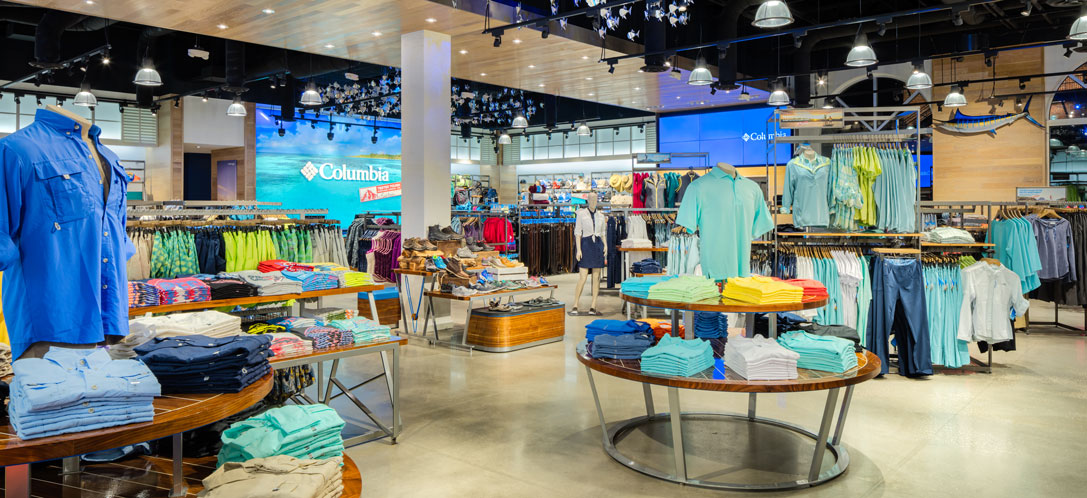
Columbia store in Disney Springs, FL (designed by BHDP)
Research Scope and Objectives
BHDP demonstrates its commitment to excellence by using research, including data collection and analysis, to serve its retail clients by designing retail stores that create positive shopping experiences. BHDP initiated this study to learn more about the behaviors of specialty retail shoppers as health and safety mandated shopping restrictions begin to lift and shoppers were permitted to visit stores again. The research hypothesis and questionnaire were developed by BHDP. Ask Your Target Market (AYTM), an independent, online research firm, gathered input from 1,000 shoppers. These shoppers were above the age of 13 and to be eligible for the survey, they needed to have purchased items from a minimum of three different specialty retailers during 2020. Respondents were from across the United States and not limited to major metropolitan areas. Information collected from respondents included gender, age, education level, employment status, income level, relationship status, ethnicity/race, employment, and parental status. The survey was launched on June 22, 2020 and closed on June 30, 2020.
The retailers included in this research were: Abercrombie & Fitch/Hollister, Altar’d State, American Eagle/Aerie, Ann Taylor/Ann Taylor Loft, Anthropologie/Urban Outfitters, Apple Store, Bath and Body Works, Burberry, Chico’s, Claire’s/Icing, Columbia Sportswear, Disney, Estee Lauder Brands (including MAC, Origins, Clinique), Gap/Old Navy, Godiva Chocolatier, L.L. Bean, Levi’s, Lululemon, Microsoft Store, Nike, Restoration Hardware, Sephora, Tiffany & Co., Under Armour, and Warby Parker.
The main objectives of the study included:
- To understand specialty retail shopper likes/dislikes (perceptions) relative to purchasing from traditional brick and mortar retail stores or outlets before, during, and after COVID-19.
- To uncover the influences on specialty retail shopper behavior.
- To identify opportunities to enhance the instore shopping experience to create stronger brand loyalty and greater frequency of instore visits.
- To discover unmet needs and missed opportunities in the specialty retail store designs.
Research Findings
BHDP’s retail strategy and design team analyzed the data from this research. More than two-thirds (67.5%) of the respondents were female. Respondents ranged from 13-years-old to older than 65 years. The age breakdown included 13-17 years old (5.4% of respondents), 18-24 years old (6.1%), 25-34 years old (17.1%), 35-44 years old (22.8%), 45-54 years old (20.5%), 55-64 years old (17.7%), and 65 years and older (10.4%).
Respondents were asked about their shopping preferences prior to the COVID-19 pandemic, currently—with COVID-19 restrictions being lifted—and after COVID-19 is gone. Prior to the onset of the pandemic almost 50% of all respondents preferred to shop always or mostly in-store, 31.4% preferred to shop mostly online with items shipped to their homes and 16.8% had no preference on how they shopped. While there were no gender differences, both the 18-24 and 25-34 age groups preferred to shop online more preceding COVID-19.
Unsurprisingly, with restrictions being lifted, only 26.1% of all respondents preferred mostly or always in-store shopping compared to over 55% desiring to shop mostly online. The same preference for online shopping was indicated in both genders and all age groups. The percentage of respondents indicating they had no preference on how they shopped increased slightly to 18.3%. Post COVID-19, the number of respondents stating they will shop mostly or always in-store increased to 39.9%, while the number who will shop mostly online with items shipped to their homes decreased to 28.4%. Additionally, respondents stating they had no preference between shopping in-store or online increased from 16.8% before the pandemic to 26.8% after the pandemic is over. This no preference trend was especially prominent in several age groups, including the 18-24 age group, which selected no preference over shopping in-store or online after the pandemic is over. The 25-34 age group remained steady with their online shopping preference. Interestingly, the other five age groups reverted to preferring in-store shopping after the pandemic is over, with the 13-17 age
group showing a 33% increase in their in-store preference.
Respondents were asked their top influences for preferring to shop in-store and were able to select multiple responses. The most selected responses were:
- Ability to compare and confirm fit, color, texture (selected the most by females and the 25-34 age group)
- Convenient store location (selected the most by males and the 18-24, 45-54, 55-64, and 65+ age groups)
- Special sales and promotions
- It’s fun to shop in-store (selected the most by the 13-17 age group)
- Affordable pricing (selected the most by the 35-44 age group).
They also were asked the number one factor that positively influenced them to return to in-store shopping. The top response, selected by 29.4% of respondents, was the ability to compare and confirm fit, color, texture. One respondent stated, “It’s more likely things will fit, and colors and textures are more accurate in person than online,” while another said, “It’s easier to browse and compare [in-store] when I’m not super sure what I want.” Instant gratification was selected by 10.6% of respondents, with one sharing, “Usually when I decide to make a purchase, I want it immediately. I do not like to wait for shipping even if it’s next day.” Other shoppers said that it “makes them feel good,” they “prefer to have it as soon as possible,” and they “love the excitement of leaving with a product instantly.” It’s fun to shop in-store was selected by 10.3% of respondents and 8.4% liked the special sales & promotions offered in-store. “I always seem to find amazing deals when I shop in person. Better than I find online,” said one respondent. Finally, 7.3% of respondents liked convenient store locations.
Conversely, respondents were asked why they would not return to a store. Too expensive was cited by 53.1% of respondents, followed by dirty/disorganized (45.7%), low inventory/out of stock (45.6%), and poor/disappointing service (42.8%). The 13-17 age group was focused on the products as product quality, weak product assortment and low inventory were in their top responses. Both genders and most age groups chose too expensive as their number one reason for not returning to a store. The 18-24 age group selected poor/disappointing service and the 25-34 selected low inventory/out of stock as their top reasons.
More than half of respondents (61.5%) stated they will not have concerns with in-store shopping post-pandemic. Respondents indicated several factors that make them feel safer or more at ease while shopping in a store. These included: hand sanitizer at entry (57.6%), cart wipes available at entry (52.3%), all employees are required to wear masks (51.1%), employees are visibly cleaning and sanitizing during store hours (50.4%), all shoppers are required to wear masks (45.2%), and the number of shoppers in the store are limited (43%). The 13-17 age group was the only group to select touchless technology as one of their top responses while the 65+ age group was the only group to select both line spacing markers at checkout and plexiglass barriers at registers in their top responses.
When asked where they feel most comfortable shopping, 27% of respondents selected independent buildings, 25% selected indoor malls and 23% selected outdoor malls. Both the 13-17 and 18-24 age groups selected indoor malls as where they feel most comfortable, followed by outdoor malls. The other age groups all selected outdoor malls followed by independent buildings as to where they feel most comfortable shopping.
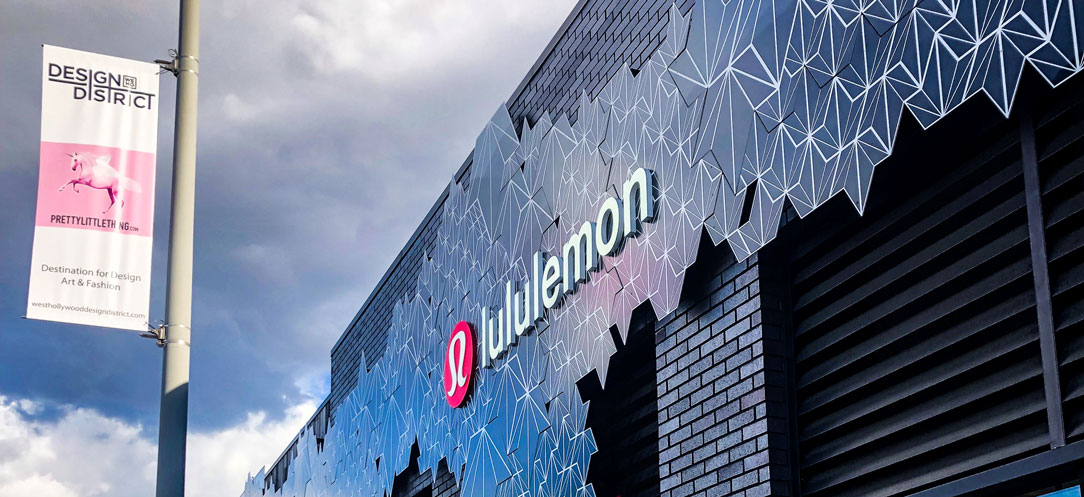
Lululemon store exterior signage in Los Angeles, CA
Analysis of Findings
The good news for retailers is there are indicators that shoppers across age groups and genders want to return to shopping instore. As expected, when COVID-19 restrictions were being relaxed, there was a dramatic drop in those currently shopping in-store as compared to those who shopped in s tore before the pandemic. Yet, the number of respondents indicating they are likely to shop mostly or always in-store after COVID-19 increased by 52.8%.
Even so, brick and mortar retailers have many obstacles to overcome. Before the pandemic, shoppers were seeking choices in how and where they shopped. A third of respondents preferred online shopping before COVID-19 and many formed new online shopping habits during the pandemic due to restrictions on brick and mortar stores. Additionally, one-half of shoppers were extremely or somewhat satisfied with their online shopping experience compared to their previous in-store experience. Only 5.5% of respondents were somewhat or extremely dissatisfied with their online experience. One shopper explained, “I don’t feel like it’s a treat to go online. I feel like it’s a chore. There is no magic of discovery. The whole point of living in Manhattan is to experience the phenomenal retail life we have here, which can’t be replicated anywhere else.”
But, while more than 50% of all respondents in this survey indicated they preferred online shopping (with either ship to home or curbside pickup) now that restrictions are being lifted, only 33.3% of all respondents are likely to mostly shop online (with either ship t o home or curbside pickup) after the pandemic is over. Just as important, the number of respondents indicating they had no preference between shopping in-store or online increased 37.3% from before COVID-19 to after the pandemic is gone, with the largest increases in the 18-24, 25-34, 55-64 and 64+ age groups. This may suggest that the shopping habits formed during the pandemic are not permanent behaviors.
In addition to preferred channel, respondents also were asked what environment in which they feel most comfortable shopping. Only 5% selected Main Street shops and 2% chose city flagship stores. If shoppers are moving to the suburbs, there is less of a need for city flagship and Main Street stores. On the other hand, 48% of those surv eyed felt most comfortable shopping in indoor and outdoor malls. Additionally, since BHDP’s “Clicks to Bricks” survey conducted in March 2020, the number of shoppers willing to travel more than 30 minutes to a store rather than shop online increased from 9.6% to 17.8% in this survey. The significant changes in shopper preferences in such a short period of time presents retailers with an opportunity to maximize their in-store offerings. It is time for retailers to reexamine their real estate strategies.
Recommendations
It is crucial for retailers to study and understand the preferences and behaviors of their instore shoppers. With state by state shutdowns and localized ‘hot-spot’ closings, centralized strategies and decision-making no longer apply. The COVID-19 crisis showed retailers the importance of knowing the shoppers who visit each of their s tores. In-store staff understand their store’s shoppers, which is why site-specific strategies are more effective at meeting shoppers’ individual needs.
Additionally, retailers need to evaluate their internal organizational structures and processes to align their channel strategies. That way, they will ensure their brand messaging and experiences are the same across all their channels. Brick and mortar brands struggle to marry their in-store and online experiences because of centralization and being siloed. Unifying online messaging and in-store brand positioning creates one tone of voice and one brand message to meet shoppers’ expectations and avoid disconnection.
I like to feel like I’m being catered to while I shop.
Survey Respondent
With a greater number of shoppers expressing no preference between shopping online or instore, it is crucial for retailers to emphasize and deliver on the advantages of their existing brick and mortar stores. The connection between retail store staff and shoppers is one that is not replicated online. Shoppers appreciate personalized services and positive experiences. “I like to feel like I’m being catered to while I shop,” said one respondent while another stated, “Employees are always nice and helpful.” Additionally, shoppers seek exceptional customer service. Only 10.5% of respondents indicated they did not want to receive any attention from an in-store sales representative. Instead, respondents appreciate friendly and knowledgeable staff. One respondent mentioned, “I have a relationship with the staff, and they do an excellent job of assisting me.” Others mentioned the helpfulness of staff, including receiving product recommendations and helping with product decisions. “It is easier to ask questions when you are in-store instead of having to wait for an online response,” pointed out one shopper.
City flagship stores may not be viable for a long time. Only 2% of shoppers surveyed indicated this is the environment they are most comfortable shopping in. They produce profit for retailers, but when there are no shoppers, they lose a significant amount of revenue. Independent buildings are the preferred choice of shoppers as 27% of them selected this option as their most comfortable shopping environment. Retailers can take advantage of this type of real estate by adding driveup capabilities and other options to satisfy shoppers’ needs. In fact, it is crucial for retailers to provide multiple omni-choice channels for shoppers as part of an upfront experience—not as an afterthought. These include curbside pickup, walk-up windows, lockers, vending capabilities, and cashless and touchless options.
Delivering for the younger shopper is a key and unique opportunity. As confirmed by this research, generation Z will prefer to shop instore, even more than pre-pandemic. It is more than just sharing on Instagram that they bought something in-store. They look for authenticity and want to learn about the brand. They want to meet the people in-store that represent the brand.
Brick and mortar retailers need to capitalize on the strengths they offer over ecommerce retailers. This includes emphasizing convenience, the shopping experience itself, product availability and price. One shopper pointed out, “Why shop online when the store is right down the street?” and another said, “I like how convenient the store is and that I can leave with my item immediately.” Several respondents mentioned that shopping is an experience they like to share with others and enjoy socializing in the retail stores. “These outings with my daughter are how we spend quality time together and have some memories made,” stated one respondent. Respondents also mentioned finding unique items and discovering new products. “The ability to purchase the new item or arrivals and taking it home that same day and not taking chances of it being sold out online,” was important for one respondent. Other respondents mentioned that low prices keep them coming back to the store and that with online shopping, the prices are usually higher, and they also have to pay for shipping plus the taxes.
Additionally, a roundtable discussion with retail leaders that was facilitated by BHDP revealed a few recommendations for retailers that are seeking to evolve and survive postpandemic. These include:
- Evaluate the traditional store model and consider alternate and smaller footprints with wider aisles, fewer merchandise displays, and reduced SKU options.
- Build more flexibility into the traditional rigid store model and real estate strategies.
- Improve mobile apps to better support emerging shopper behaviors and styles.
- Bolster the capacity of e-commerce platforms to eliminate current and future product shortages.
- Expand the use of buy online and pick-up in store (BOPIS) and give shoppers better contactless options, including more drive-thru, walk-up windows and curbside pick-up.
- Perfect omni-channel strategies and bridge the gap between online and instore to create a seamless and frictionless experience for shoppers.
To help retailers redesign existing stores and plan new ones, it is important for them to consider the factors that influenced the respondents to return or not return to in-store shopping while engaging in a Purposeful Design approach. One retailer who attended BHDP’s virtual roundtable in July 2020 stated, “Omni-channel is a key initiative for us. We are in the process of blending the online world with the brick-and mortar world.” Another roundtable participant said, “We have built a customer we did not have before, but we continue to build that with the brick-and-mortar customer. We are trying to make the omni-channel the best experience.”
Because retailers, for the most part, are no longer owning location, quality, selection, price and service, memorable retail experience touchpoints need to be realigned to deliver omni-choice options. Holistic approaches to multi-channel messaging and experiences will better fulfill shopper expectations. Delivering more meaningful touchpoints in the brick
and mortar store can create the experiences shoppers are seeking.
We have built a customer we did not have before, but we continue to build that with the brick-and-mortar customer. We are trying to make the omni-channel the best experience.
Specialty Retailer
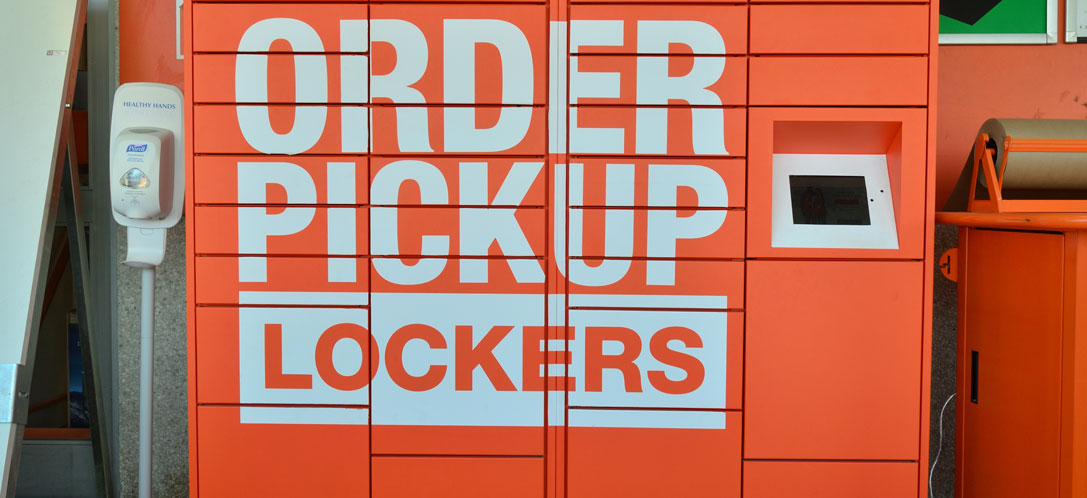
Pick-up lockers at Home Depot
Conclusion
Surviving in today’s competitive and evolving landscape means retailers must correctly adapt to shoppers’ changing needs and desires or risk falling further behind. The shift o ver the years in shopper behavior towards online shopping is persuading brick and mortar retailers to reevaluate how stores are located, planned and designed. Retail spaces can focus on their shoppers’ multi-tiered and changing purchase preferences and shopping behaviors to ensure higher brand loyalty and sales. Shoppers’ behaviors are still in a state of change and permanent patterns have not emerged. With retailers continuing to evolve, these shoppers’ behaviors and expectations need to be monitored carefully by retailers.
It is also no longer about buying transactions, but about making the experience of shopping seamlessly between online and the physical space memorable and enjoyable. This paves the way for unified channel efforts to be brought to life in-store. To get ahead, retailers can meet shopper expectations by continually gathering information on their shoppers to understand their habits and behaviors and delivering on shopper expectations through omni-channel strategies. Those retailers who invest in the combination of the online and brick and mortar shopper experience are starting to see some success. In part, that is due to a Purposeful Design approach to planning and designing stores, one where all the disciplines are involved in conceiving, merchandising, building, and running stores to create a collaborative, shopper-focused, and data-driven process.
One respondent in this survey summed it up by saying, “Local retail is struggling. It is more convenient, and I am able to get items in a timely fashion but helping retailers through this unprecedented time is critical. If the retailers that I am loyal to disappear, I will have nowhere to turn to for my groceries, clothes, etc.” Retailers that already offered some aspect of omni-choice fared well during the pandemic. To attract these shoppers to come into brick and mortar stores, retailers need to develop strong omni-channel solutions. The shift in shopper control and change in behaviors requires new thinking and approaches. Doing so with an omni-choice viewpoint enables retailers to serve the needs of their shoppers while preparing for the future.
Local retail is struggling ... helping retailers through this unprecedented time is critical.


